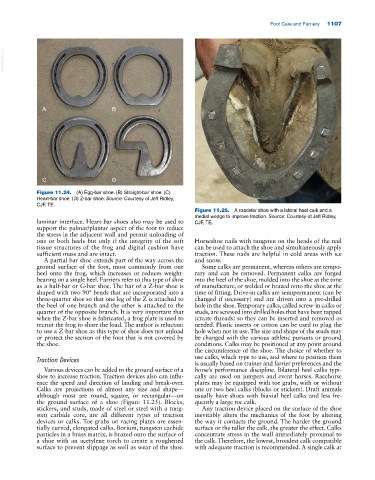Page 1141 - Adams and Stashak's Lameness in Horses, 7th Edition
P. 1141
Foot Care and Farriery 1107
VetBooks.ir
A B
C D
Figure 11.24. (A) Egg‐bar shoe. (B) Straight‐bar shoe. (C)
Heart‐bar shoe. (D) Z‐bar shoe. Source: Courtesy of Jeff Ridley,
CJF, TE.
Figure 11.25. A roadster shoe with a lateral heel calk and a
medial wedge to improve traction. Source: Courtesy of Jeff Ridley,
laminar interface. Heart‐bar shoes also may be used to CJF, TE.
support the palmar/plantar aspect of the foot to reduce
the stress in the adjacent wall and permit unloading of
one or both heels but only if the integrity of the soft Horseshoe nails with tungsten on the heads of the nail
tissue structures of the frog and digital cushion have can be used to attach the shoe and simultaneously apply
sufficient mass and are intact. traction. These nails are helpful in cold areas with ice
A partial bar shoe extends part of the way across the and snow.
ground surface of the foot, most commonly from one Some calks are permanent, whereas others are tempo
heel onto the frog, which increases or reduces weight‐ rary and can be removed. Permanent calks are forged
bearing on a single heel. Farriers refer to this type of shoe into the heel of the shoe, molded into the shoe at the time
as a half‐bar or G‐bar shoe. The bar of a Z‐bar shoe is of manufacture, or welded or brazed onto the shoe at the
shaped with two 90° bends that are incorporated into a time of fitting. Drive‐in calks are semipermanent (can be
three‐quarter shoe so that one leg of the Z is attached to changed if necessary) and are driven into a pre‐drilled
the heel of one branch and the other is attached to the hole in the shoe. Temporary calks, called screw‐in calks or
quarter of the opposite branch. It is very important that studs, are screwed into drilled holes that have been tapped
when the Z‐bar shoe is fabricated, a frog plate is used to (create threads) so they can be inserted and removed as
recruit the frog to share the load. The author is reluctant needed. Plastic inserts or cotton can be used to plug the
to use a Z‐bar shoe as this type of shoe does not unload hole when not in use. The size and shape of the studs may
or protect the section of the foot that is not covered by be changed with the various athletic pursuits or ground
the shoe. conditions. Calks may be positioned at any point around
the circumference of the shoe. The choice of whether to
Traction Devices use calks, which type to use, and where to position them
is usually based on trainer and farrier preferences and the
Various devices can be added to the ground surface of a horse’s performance discipline. Bilateral heel calks typi
shoe to increase traction. Traction devices also can influ cally are used on jumpers and event horses. Racehorse
ence the speed and direction of landing and break‐over. plates may be equipped with toe grabs, with or without
Calks are projections of almost any size and shape— one or two heel calks (blocks or stickers). Draft animals
although most are round, square, or rectangular—on usually have shoes with biaxial heel calks and less fre
the ground surface of a shoe (Figure 11.25). Blocks, quently a large toe calk.
stickers, and studs, made of steel or steel with a tung Any traction device placed on the surface of the shoe
sten carbide core, are all different types of traction inevitably alters the mechanics of the foot by altering
devices or calks. Toe grabs on racing plates are essen the way it contacts the ground. The harder the ground
tially curved, elongated calks. Borium, tungsten carbide surface or the taller the calk, the greater the effect. Calks
particles in a brass matrix, is brazed onto the surface of concentrate stress in the wall immediately proximal to
a shoe with an acetylene torch to create a roughened the calk. Therefore, the lowest, broadest calk compatible
surface to prevent slippage as well as wear of the shoe. with adequate traction is recommended. A single calk at

